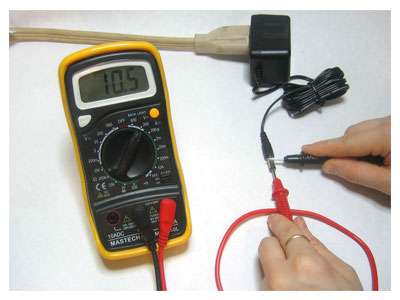Key Takeaway
To check the voltage of a power supply, you’ll need a multimeter. First, set your multimeter to the appropriate voltage range. Then, connect the multimeter probes to the power supply terminals: the red probe to the positive terminal and the black probe to the negative terminal. Make sure the power supply is on. Read the voltage displayed on the multimeter. This reading shows the voltage output of your power supply. If the voltage is within the expected range, your power supply is working correctly. If not, there may be an issue that needs addressing.
Tools and Equipment Needed
Before starting any voltage check, it’s crucial to gather the necessary tools and equipment. A digital multimeter is essential for accurate readings. Ensure it’s in good working condition. You’ll also need insulated gloves and safety goggles to protect yourself from potential electrical hazards. If you’re working on a high-voltage system, a non-contact voltage tester can help you identify live wires without direct contact. Additionally, having a set of screwdrivers and pliers can be handy for accessing the power supply terminals. Always keep a notepad and pen ready to record your readings and observations for future reference.

Safety Precautions
Safety is paramount in industrial applications, especially when dealing with electrical systems. Before starting any work, ensure the power supply is completely turned off and unplugged. This step is crucial to avoid any accidental electric shocks. Always use insulated gloves and wear safety goggles. These simple protective measures can prevent serious injuries. Additionally, inspect your surroundings for water or moisture since electricity and water are a dangerous combination. Ensure your work area is well-lit and free from any obstructions. Always work with a colleague nearby in case of an emergency. In case of an incident, having someone else present can be a lifesaver.
Before proceeding, double-check all your equipment for any signs of damage or wear. This includes checking cables for frays and ensuring all tools are in proper working order. Taking these precautions seriously can prevent accidents and ensure a safer working environment. Remember, safety should never be compromised. By following these steps, you not only protect yourself but also set a standard of safety for others in the workplace. Making safety a priority is crucial for effective and efficient work in any industrial setting.
Step-by-Step Testing Guide
Accurately testing the voltage of a power supply is a critical skill in industrial applications. Start by setting your digital multimeter to the appropriate voltage range, either AC or DC, based on your power supply type. Connect the black probe to the common (COM) terminal and the red probe to the voltage (V) terminal on the multimeter. Once the power supply is properly connected and turned on, carefully touch the black probe to the ground or negative terminal and the red probe to the positive terminal. Read the voltage displayed on the multimeter. This reading indicates the output voltage of the power supply.
Record this voltage in your notepad for further analysis. Accurate voltage readings are essential for diagnosing and troubleshooting power supply issues. By following this methodical approach, you ensure that your measurements are reliable and informative. This process helps in identifying any discrepancies in voltage output, which can be critical for maintaining the performance and safety of your industrial equipment. Consistent practice of these steps will enhance your proficiency and confidence in handling electrical systems.
Interpreting Results
Understanding the voltage readings from your power supply is crucial for diagnosing potential issues. Compare the measured voltage with the specified output voltage of the power supply. If the voltage is within the acceptable range, your power supply is functioning correctly. However, if the voltage is significantly higher or lower, it may indicate a problem. Consistently low voltage can suggest an overloaded power supply or faulty components. High voltage readings can indicate issues with the voltage regulator or other internal problems.
Proper interpretation of these results helps in ensuring your equipment operates safely and efficiently. It’s essential to diagnose these issues accurately to maintain the reliability of your industrial systems. Regularly monitoring and interpreting these voltage readings can also help in preventive maintenance. By understanding the normal operating ranges, you can quickly identify and address any anomalies. This proactive approach not only extends the life of your equipment but also ensures consistent performance, reducing downtime and increasing productivity.
Troubleshooting Common Issues
Voltage irregularities in a power supply can stem from various issues, and troubleshooting them is essential for maintaining system performance. If you encounter low voltage, check for any loose or corroded connections, which can impede electrical flow. Inspect the power supply for signs of overheating, as this can damage internal components. For high voltage issues, ensure the voltage regulator is functioning properly. It might be necessary to replace faulty capacitors or resistors. If the power supply isn’t working at all, check the fuse and replace it if needed.
Regular maintenance and thorough inspections are crucial for preventing these common problems. By addressing these issues promptly, you can ensure the longevity and reliability of your industrial equipment. Regularly scheduled maintenance checks help in identifying potential issues before they escalate. This proactive approach minimizes downtime and keeps your operations running smoothly. Always keep spare parts and tools handy to quickly address any issues that arise. Effective troubleshooting and maintenance practices are key to sustaining the efficiency and safety of your power supply systems.
Conclusion
Checking the voltage of a power supply is a fundamental skill for any engineer working in the industry. By following the proper steps and safety precautions, you can ensure accurate readings and maintain the integrity of your electrical systems. Understanding how to interpret these readings and troubleshoot common issues will enhance your ability to keep equipment running smoothly. Always prioritize safety and accuracy, and don’t hesitate to consult with more experienced colleagues if you encounter unfamiliar problems. Regular practice and diligence in checking power supply voltage will contribute to your overall expertise and reliability in the field.
